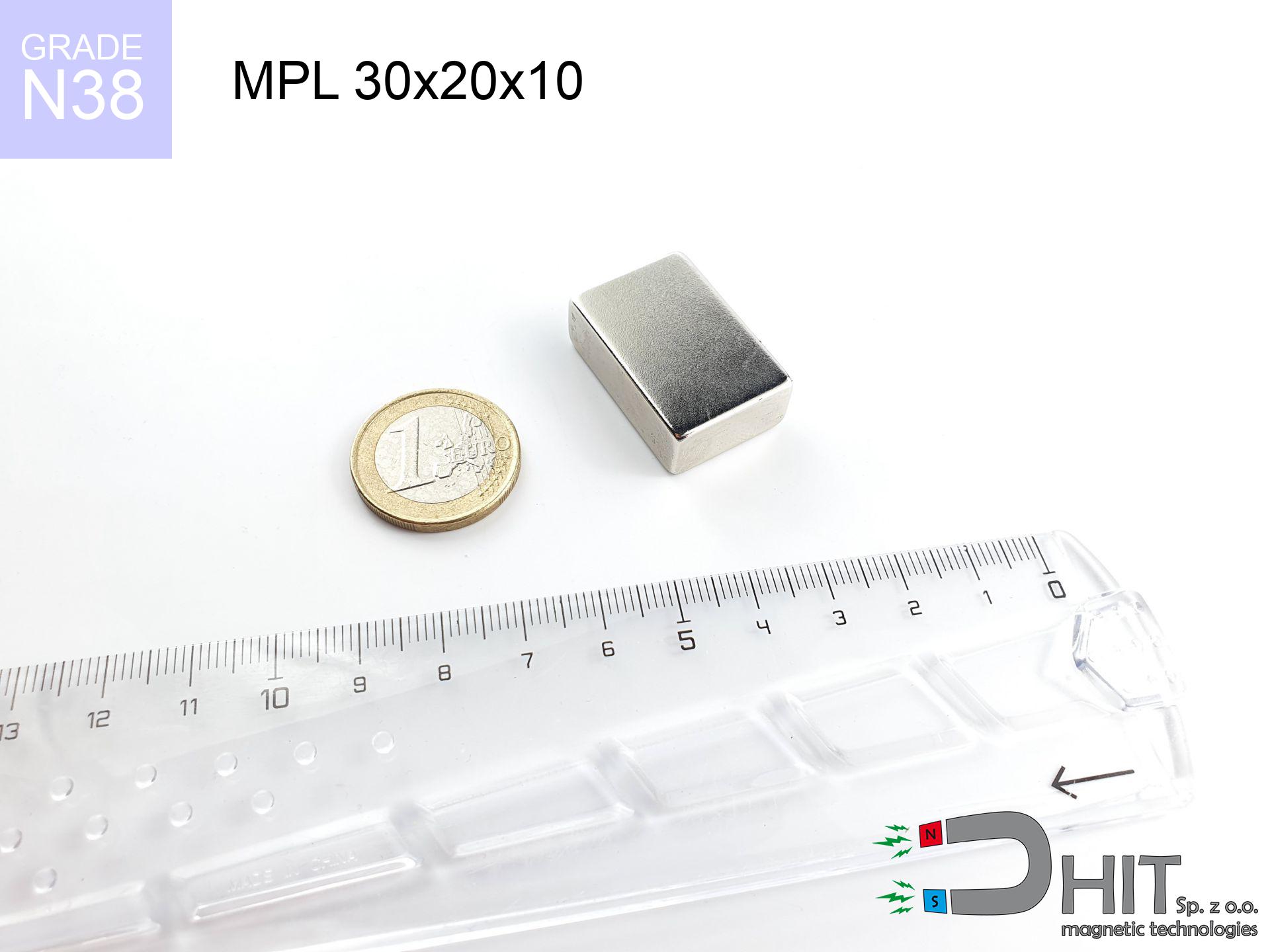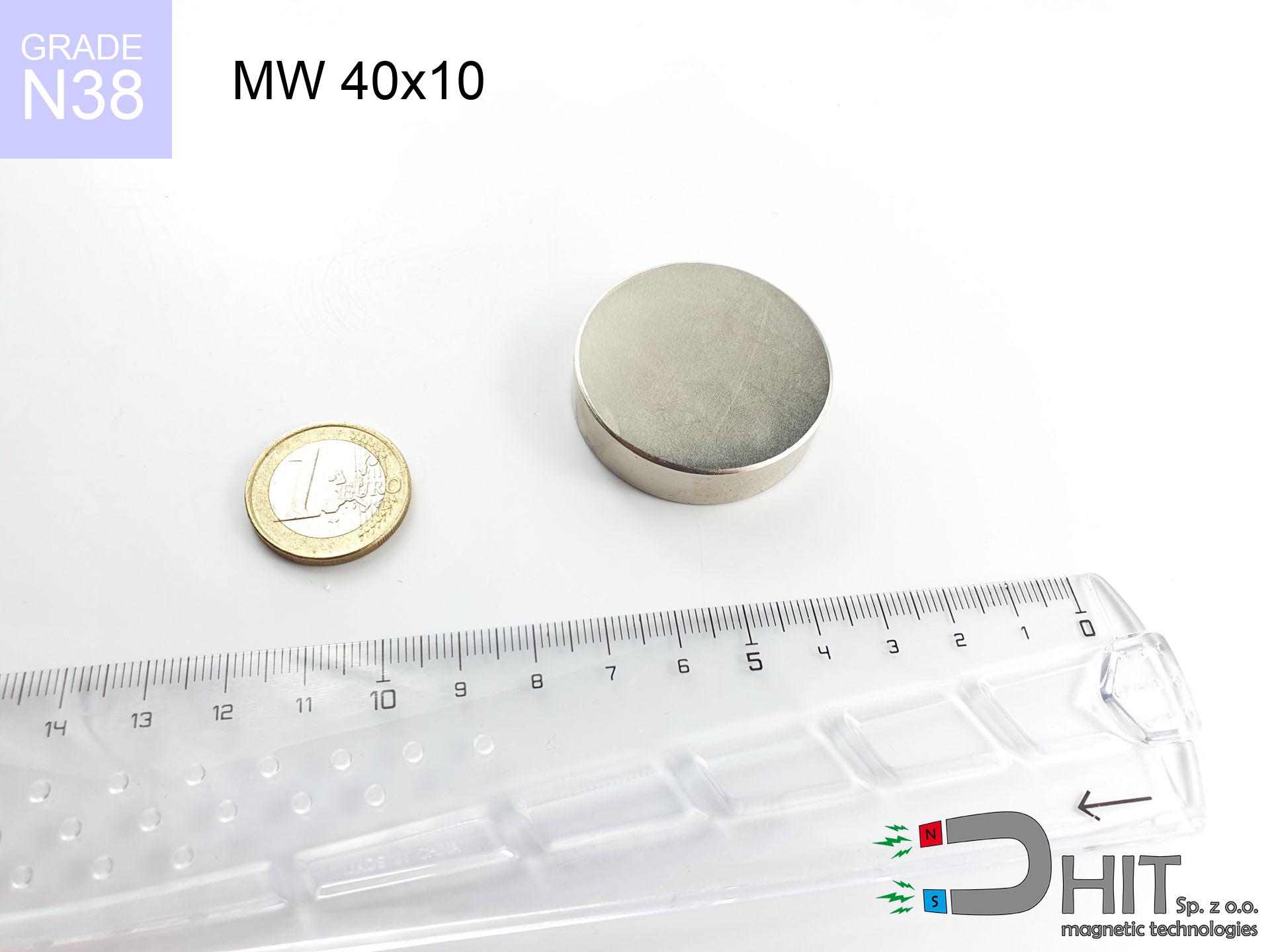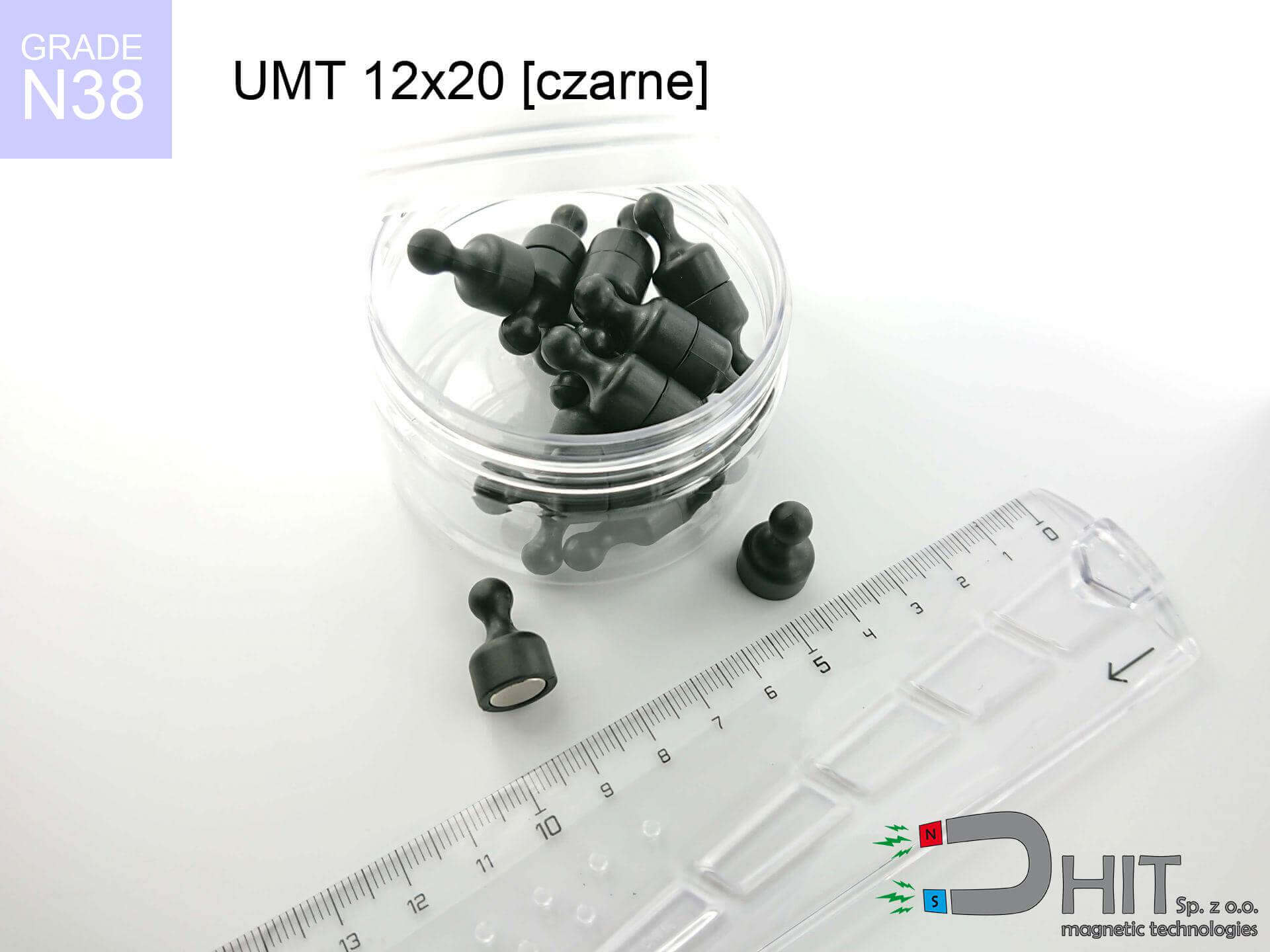MPL 30x20x10 / N38 - lamellar magnet
lamellar magnet
Catalog no 020141
GTIN/EAN: 5906301811473
length
30 mm [±0,1 mm]
Width
20 mm [±0,1 mm]
Height
10 mm [±0,1 mm]
Weight
45 g
Magnetization Direction
↑ axial
Load capacity
19.53 kg / 191.55 N
Magnetic Induction
371.57 mT / 3716 Gs
Coating
[NiCuNi] Nickel
16.11 ZŁ with VAT / pcs + price for transport
13.10 ZŁ net + 23% VAT / pcs
bulk discounts:
Need more?Need help making a decision?
Contact us by phone
+48 888 99 98 98
alternatively drop us a message by means of
contact form
our website.
Weight and form of magnetic components can be verified using our
force calculator.
Orders submitted before 14:00 will be dispatched today!
MPL 30x20x10 / N38 - lamellar magnet
Specification / characteristics MPL 30x20x10 / N38 - lamellar magnet
| properties | values |
|---|---|
| Cat. no. | 020141 |
| GTIN/EAN | 5906301811473 |
| Production/Distribution | Dhit sp. z o.o. |
| Country of origin | Poland / China / Germany |
| Customs code | 85059029 |
| length | 30 mm [±0,1 mm] |
| Width | 20 mm [±0,1 mm] |
| Height | 10 mm [±0,1 mm] |
| Weight | 45 g |
| Magnetization Direction | ↑ axial |
| Load capacity ~ ? | 19.53 kg / 191.55 N |
| Magnetic Induction ~ ? | 371.57 mT / 3716 Gs |
| Coating | [NiCuNi] Nickel |
| Manufacturing Tolerance | ±0.1 mm |
Magnetic properties of material N38
| properties | values | units |
|---|---|---|
| remenance Br [min. - max.] ? | 12.2-12.6 | kGs |
| remenance Br [min. - max.] ? | 1220-1260 | mT |
| coercivity bHc ? | 10.8-11.5 | kOe |
| coercivity bHc ? | 860-915 | kA/m |
| actual internal force iHc | ≥ 12 | kOe |
| actual internal force iHc | ≥ 955 | kA/m |
| energy density [min. - max.] ? | 36-38 | BH max MGOe |
| energy density [min. - max.] ? | 287-303 | BH max KJ/m |
| max. temperature ? | ≤ 80 | °C |
Physical properties of sintered neodymium magnets Nd2Fe14B at 20°C
| properties | values | units |
|---|---|---|
| Vickers hardness | ≥550 | Hv |
| Density | ≥7.4 | g/cm3 |
| Curie Temperature TC | 312 - 380 | °C |
| Curie Temperature TF | 593 - 716 | °F |
| Specific resistance | 150 | μΩ⋅cm |
| Bending strength | 250 | MPa |
| Compressive strength | 1000~1100 | MPa |
| Thermal expansion parallel (∥) to orientation (M) | (3-4) x 10-6 | °C-1 |
| Thermal expansion perpendicular (⊥) to orientation (M) | -(1-3) x 10-6 | °C-1 |
| Young's modulus | 1.7 x 104 | kg/mm² |
Technical analysis of the magnet - data
The following data represent the outcome of a physical calculation. Values were calculated on algorithms for the material Nd2Fe14B. Real-world parameters may deviate from the simulation results. Treat these calculations as a supplementary guide when designing systems.
MPL 30x20x10 / N38
| Distance (mm) | Induction (Gauss) / mT | Pull Force (kg) | Risk Status |
|---|---|---|---|
| 0 mm |
3715 Gs
371.5 mT
|
19.53 kg / 19530.0 g
191.6 N
|
critical level |
| 1 mm |
3464 Gs
346.4 mT
|
16.98 kg / 16983.1 g
166.6 N
|
critical level |
| 2 mm |
3197 Gs
319.7 mT
|
14.47 kg / 14466.6 g
141.9 N
|
critical level |
| 3 mm |
2927 Gs
292.7 mT
|
12.12 kg / 12123.3 g
118.9 N
|
critical level |
| 5 mm |
2408 Gs
240.8 mT
|
8.21 kg / 8207.8 g
80.5 N
|
warning |
| 10 mm |
1411 Gs
141.1 mT
|
2.82 kg / 2815.6 g
27.6 N
|
warning |
| 15 mm |
832 Gs
83.2 mT
|
0.98 kg / 979.7 g
9.6 N
|
safe |
| 20 mm |
512 Gs
51.2 mT
|
0.37 kg / 371.2 g
3.6 N
|
safe |
| 30 mm |
224 Gs
22.4 mT
|
0.07 kg / 70.7 g
0.7 N
|
safe |
| 50 mm |
65 Gs
6.5 mT
|
0.01 kg / 6.0 g
0.1 N
|
safe |
MPL 30x20x10 / N38
| Distance (mm) | Friction coefficient | Pull Force (kg) |
|---|---|---|
| 0 mm | Stal (~0.2) |
3.91 kg / 3906.0 g
38.3 N
|
| 1 mm | Stal (~0.2) |
3.40 kg / 3396.0 g
33.3 N
|
| 2 mm | Stal (~0.2) |
2.89 kg / 2894.0 g
28.4 N
|
| 3 mm | Stal (~0.2) |
2.42 kg / 2424.0 g
23.8 N
|
| 5 mm | Stal (~0.2) |
1.64 kg / 1642.0 g
16.1 N
|
| 10 mm | Stal (~0.2) |
0.56 kg / 564.0 g
5.5 N
|
| 15 mm | Stal (~0.2) |
0.20 kg / 196.0 g
1.9 N
|
| 20 mm | Stal (~0.2) |
0.07 kg / 74.0 g
0.7 N
|
| 30 mm | Stal (~0.2) |
0.01 kg / 14.0 g
0.1 N
|
| 50 mm | Stal (~0.2) |
0.00 kg / 2.0 g
0.0 N
|
MPL 30x20x10 / N38
| Surface type | Friction coefficient / % Mocy | Max load (kg) |
|---|---|---|
| Raw steel |
µ = 0.3
30% Nominalnej Siły
|
5.86 kg / 5859.0 g
57.5 N
|
| Painted steel (standard) |
µ = 0.2
20% Nominalnej Siły
|
3.91 kg / 3906.0 g
38.3 N
|
| Oily/slippery steel |
µ = 0.1
10% Nominalnej Siły
|
1.95 kg / 1953.0 g
19.2 N
|
| Magnet with anti-slip rubber |
µ = 0.5
50% Nominalnej Siły
|
9.77 kg / 9765.0 g
95.8 N
|
MPL 30x20x10 / N38
| Steel thickness (mm) | % power | Real pull force (kg) |
|---|---|---|
| 0.5 mm |
|
0.98 kg / 976.5 g
9.6 N
|
| 1 mm |
|
2.44 kg / 2441.3 g
23.9 N
|
| 2 mm |
|
4.88 kg / 4882.5 g
47.9 N
|
| 5 mm |
|
12.21 kg / 12206.3 g
119.7 N
|
| 10 mm |
|
19.53 kg / 19530.0 g
191.6 N
|
MPL 30x20x10 / N38
| Ambient temp. (°C) | Power loss | Remaining pull | Status |
|---|---|---|---|
| 20 °C | 0.0% |
19.53 kg / 19530.0 g
191.6 N
|
OK |
| 40 °C | -2.2% |
19.10 kg / 19100.3 g
187.4 N
|
OK |
| 60 °C | -4.4% |
18.67 kg / 18670.7 g
183.2 N
|
|
| 80 °C | -6.6% |
18.24 kg / 18241.0 g
178.9 N
|
|
| 100 °C | -28.8% |
13.91 kg / 13905.4 g
136.4 N
|
MPL 30x20x10 / N38
| Gap (mm) | Attraction (kg) (N-S) | Repulsion (kg) (N-N) |
|---|---|---|
| 0 mm |
51.05 kg / 51046 g
500.8 N
5 124 Gs
|
N/A |
| 1 mm |
47.76 kg / 47756 g
468.5 N
7 186 Gs
|
42.98 kg / 42981 g
421.6 N
~0 Gs
|
| 2 mm |
44.39 kg / 44389 g
435.5 N
6 928 Gs
|
39.95 kg / 39950 g
391.9 N
~0 Gs
|
| 3 mm |
41.06 kg / 41060 g
402.8 N
6 663 Gs
|
36.95 kg / 36954 g
362.5 N
~0 Gs
|
| 5 mm |
34.68 kg / 34678 g
340.2 N
6 124 Gs
|
31.21 kg / 31210 g
306.2 N
~0 Gs
|
| 10 mm |
21.45 kg / 21453 g
210.5 N
4 817 Gs
|
19.31 kg / 19308 g
189.4 N
~0 Gs
|
| 20 mm |
7.36 kg / 7359 g
72.2 N
2 821 Gs
|
6.62 kg / 6623 g
65.0 N
~0 Gs
|
| 50 mm |
0.40 kg / 405 g
4.0 N
662 Gs
|
0.36 kg / 364 g
3.6 N
~0 Gs
|
MPL 30x20x10 / N38
| Object / Device | Limit (Gauss) / mT | Safe distance |
|---|---|---|
| Pacemaker | 5 Gs (0.5 mT) | 13.0 cm |
| Hearing aid | 10 Gs (1.0 mT) | 10.0 cm |
| Mechanical watch | 20 Gs (2.0 mT) | 8.0 cm |
| Mobile device | 40 Gs (4.0 mT) | 6.5 cm |
| Car key | 50 Gs (5.0 mT) | 6.0 cm |
| Payment card | 400 Gs (40.0 mT) | 2.5 cm |
| HDD hard drive | 600 Gs (60.0 mT) | 2.0 cm |
MPL 30x20x10 / N38
| Start from (mm) | Speed (km/h) | Energy (J) | Predicted outcome |
|---|---|---|---|
| 10 mm |
22.82 km/h
(6.34 m/s)
|
0.90 J | |
| 30 mm |
36.47 km/h
(10.13 m/s)
|
2.31 J | |
| 50 mm |
46.99 km/h
(13.05 m/s)
|
3.83 J | |
| 100 mm |
66.44 km/h
(18.46 m/s)
|
7.66 J |
MPL 30x20x10 / N38
| Technical parameter | Value / Description |
|---|---|
| Coating type | [NiCuNi] Nickel |
| Layer structure | Nickel - Copper - Nickel |
| Layer thickness | 10-20 µm |
| Salt spray test (SST) ? | 24 h |
| Recommended environment | Indoors only (dry) |
MPL 30x20x10 / N38
| Parameter | Value | SI Unit / Description |
|---|---|---|
| Magnetic Flux | 22 801 Mx | 228.0 µWb |
| Pc Coefficient | 0.46 | Low (Flat) |
MPL 30x20x10 / N38
| Environment | Effective steel pull | Effect |
|---|---|---|
| Air (land) | 19.53 kg | Standard |
| Water (riverbed) |
22.36 kg
(+2.83 kg Buoyancy gain)
|
+14.5% |
1. Sliding resistance
*Caution: On a vertical wall, the magnet holds just ~20% of its perpendicular strength.
2. Efficiency vs thickness
*Thin steel (e.g. 0.5mm PC case) severely limits the holding force.
3. Temperature resistance
*For standard magnets, the safety limit is 80°C.
4. Demagnetization curve and operating point (B-H)
chart generated for the permeance coefficient Pc (Permeance Coefficient) = 0.46
This simulation demonstrates the magnetic stability of the selected magnet under specific geometric conditions. The solid red line represents the demagnetization curve (material potential), while the dashed blue line is the load line based on the magnet's geometry. The Pc (Permeance Coefficient), also known as the load line slope, is a dimensionless value that describes the relationship between the magnet's shape and its magnetic stability. The intersection of these two lines (the black dot) is the operating point — it determines the actual magnetic flux density generated by the magnet in this specific configuration. A higher Pc value means the magnet is more 'slender' (tall relative to its area), resulting in a higher operating point and better resistance to irreversible demagnetization caused by external fields or temperature. A value of 0.42 is relatively low (typical for flat magnets), meaning the operating point is closer to the 'knee' of the curve — caution is advised when operating at temperatures near the maximum limit to avoid strength loss.
Chemical composition
| iron (Fe) | 64% – 68% |
| neodymium (Nd) | 29% – 32% |
| boron (B) | 1.1% – 1.2% |
| dysprosium (Dy) | 0.5% – 2.0% |
| coating (Ni-Cu-Ni) | < 0.05% |
Sustainability
| recyclability (EoL) | 100% |
| recycled raw materials | ~10% (pre-cons) |
| carbon footprint | low / zredukowany |
| waste code (EWC) | 16 02 16 |
Other proposals
Strengths as well as weaknesses of neodymium magnets.
Pros
- They have unchanged lifting capacity, and over more than ten years their performance decreases symbolically – ~1% (according to theory),
- Magnets effectively defend themselves against loss of magnetization caused by foreign field sources,
- A magnet with a metallic nickel surface is more attractive,
- Magnetic induction on the surface of the magnet is exceptional,
- Thanks to resistance to high temperature, they are able to function (depending on the shape) even at temperatures up to 230°C and higher...
- Thanks to versatility in forming and the capacity to adapt to client solutions,
- Key role in innovative solutions – they are used in HDD drives, drive modules, medical devices, also industrial machines.
- Compactness – despite small sizes they provide effective action, making them ideal for precision applications
Weaknesses
- Brittleness is one of their disadvantages. Upon intense impact they can fracture. We advise keeping them in a strong case, which not only secures them against impacts but also increases their durability
- Neodymium magnets decrease their strength under the influence of heating. As soon as 80°C is exceeded, many of them start losing their power. Therefore, we recommend our special magnets marked [AH], which maintain stability even at temperatures up to 230°C
- Magnets exposed to a humid environment can rust. Therefore during using outdoors, we advise using waterproof magnets made of rubber, plastic or other material resistant to moisture
- Limited possibility of producing threads in the magnet and complicated forms - preferred is cover - magnet mounting.
- Possible danger to health – tiny shards of magnets are risky, if swallowed, which is particularly important in the context of child health protection. Additionally, small elements of these products are able to complicate diagnosis medical when they are in the body.
- Due to complex production process, their price exceeds standard values,
Lifting parameters
Maximum magnetic pulling force – what it depends on?
- with the use of a yoke made of low-carbon steel, ensuring maximum field concentration
- whose thickness reaches at least 10 mm
- characterized by smoothness
- under conditions of gap-free contact (metal-to-metal)
- for force acting at a right angle (in the magnet axis)
- at ambient temperature approx. 20 degrees Celsius
Practical aspects of lifting capacity – factors
- Distance (between the magnet and the plate), because even a very small clearance (e.g. 0.5 mm) can cause a reduction in lifting capacity by up to 50% (this also applies to varnish, corrosion or dirt).
- Angle of force application – maximum parameter is obtained only during pulling at a 90° angle. The resistance to sliding of the magnet along the plate is usually many times lower (approx. 1/5 of the lifting capacity).
- Metal thickness – the thinner the sheet, the weaker the hold. Part of the magnetic field penetrates through instead of generating force.
- Steel type – low-carbon steel gives the best results. Alloy admixtures lower magnetic permeability and holding force.
- Smoothness – full contact is obtained only on smooth steel. Any scratches and bumps reduce the real contact area, weakening the magnet.
- Thermal factor – hot environment reduces magnetic field. Too high temperature can permanently damage the magnet.
Holding force was tested on a smooth steel plate of 20 mm thickness, when the force acted perpendicularly, whereas under attempts to slide the magnet the lifting capacity is smaller. In addition, even a slight gap between the magnet’s surface and the plate decreases the load capacity.
Powerful field
Handle with care. Rare earth magnets attract from a long distance and snap with massive power, often quicker than you can move away.
Adults only
NdFeB magnets are not suitable for play. Accidental ingestion of a few magnets can lead to them pinching intestinal walls, which constitutes a critical condition and requires immediate surgery.
Medical interference
Health Alert: Strong magnets can deactivate heart devices and defibrillators. Do not approach if you have medical devices.
Cards and drives
Avoid bringing magnets near a wallet, laptop, or TV. The magnetism can irreversibly ruin these devices and wipe information from cards.
Operating temperature
Monitor thermal conditions. Exposing the magnet above 80 degrees Celsius will ruin its magnetic structure and pulling force.
Skin irritation risks
Certain individuals suffer from a contact allergy to nickel, which is the standard coating for NdFeB magnets. Frequent touching may cause dermatitis. We strongly advise wear safety gloves.
Machining danger
Dust generated during machining of magnets is combustible. Avoid drilling into magnets without proper cooling and knowledge.
Fragile material
Despite the nickel coating, neodymium is brittle and cannot withstand shocks. Avoid impacts, as the magnet may shatter into hazardous fragments.
Keep away from electronics
A powerful magnetic field disrupts the functioning of magnetometers in smartphones and GPS navigation. Do not bring magnets near a smartphone to prevent breaking the sensors.
Finger safety
Danger of trauma: The pulling power is so immense that it can result in hematomas, crushing, and broken bones. Use thick gloves.




![SM 18x125 [2xM5] / N42 - magnetic separator SM 18x125 [2xM5] / N42 - magnetic separator](https://cdn3.dhit.pl/graphics/products/sm-18x125-2xm5-cij.jpg)
![SM 25x275 [2xM8] / N42 - magnetic separator SM 25x275 [2xM8] / N42 - magnetic separator](https://cdn3.dhit.pl/graphics/products/sm-25x275-2xm8-boc.jpg)



